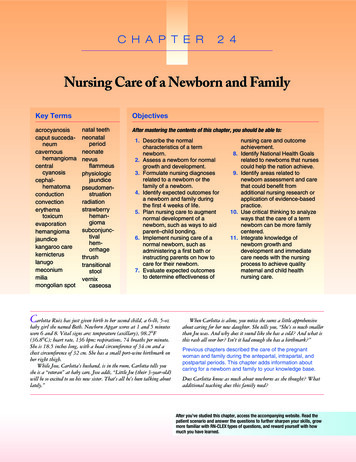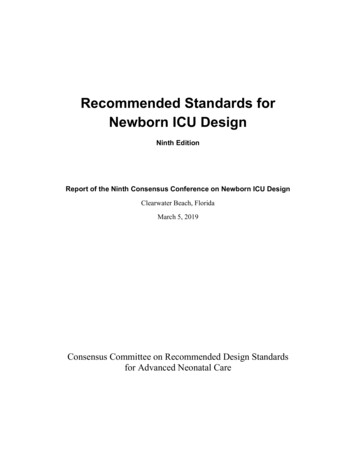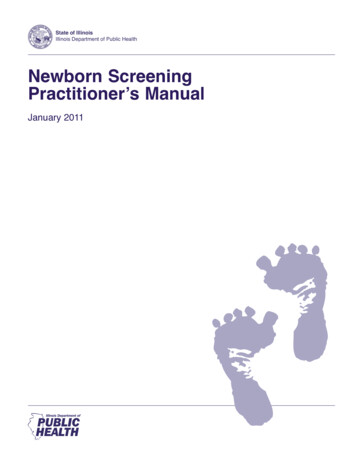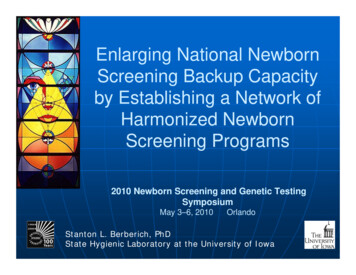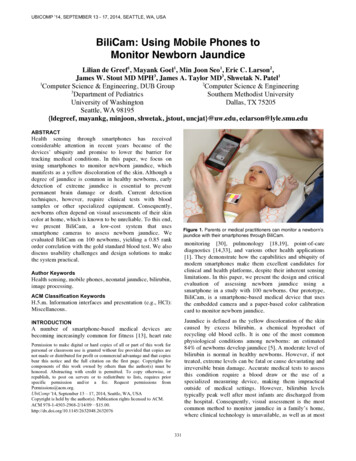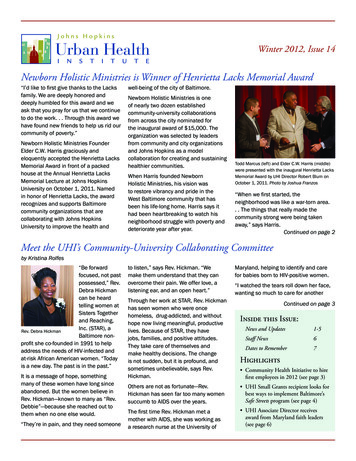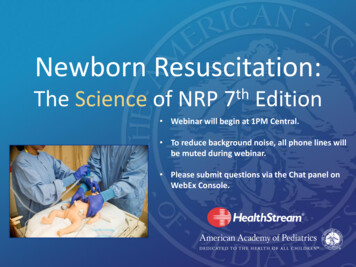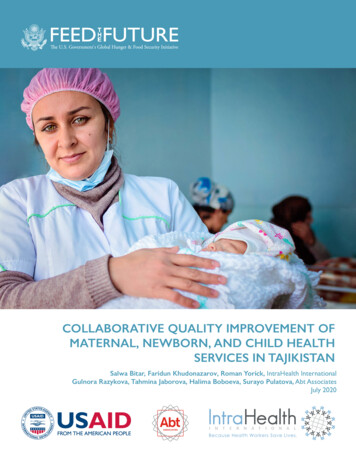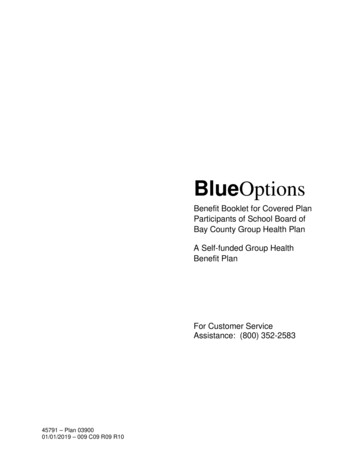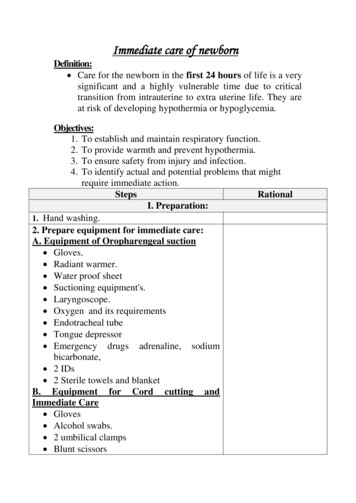
Transcription
Immediate care of newbornDefinition: Care for the newborn in the first 24 hours of life is a verysignificant and a highly vulnerable time due to criticaltransition from intrauterine to extra uterine life. They areat risk of developing hypothermia or hypoglycemia.Objectives:1. To establish and maintain respiratory function.2. To provide warmth and prevent hypothermia.3. To ensure safety from injury and infection.4. To identify actual and potential problems that mightrequire immediate action.StepsRationalI. Preparation:1. Hand washing.2. Prepare equipment for immediate care:A. Equipment of Oropharengeal suction Gloves. Radiant warmer. Water proof sheet Suctioning equipment's. Laryngoscope. Oxygen and its requirements Endotracheal tube Tongue depressor Emergency drugs adrenaline, sodiumbicarbonate, 2 IDs 2 Sterile towels and blanketB. Equipment for Cord cutting andImmediate Care Gloves Alcohol swabs. 2 umbilical clamps Blunt scissors
Sterile gauzeC. Equipment for Routinely Care Gloves Alcohol swabs. Sterile gauze Tape measures Watch Syringe Thermometer Diaper Infants Clothes Vitamin K3. Prepare environment:Keep clean and warm environment4. Patient:Assess maternal condition:(Age, gravid, Para, blood group &RH, anydrugs or complications during pregnancy).Vitalsigns pulse, respiration & temperature.III. Implementation1.Oro-pharengeal Suctioning: Wipe the neonate’s mouth with a piece ofgauze around your index finger once hishead has been delivered. Suction the neonate’s mouth with adisposable suctioning. Starts in the mouththen, the nose Do suction of oropharyngeal canal. Oxygen may be given.To prevent infection forthe mother and the babySuction the neonate’smouth with a disposableSuctioning. Starts in themouth then, the nose toprevent aspiration.
See figure (3), (4).Fig. (3) Suction from noseFig. (4) Suction from mouth2.Clamp and cutting the cord and Immediatecare of umbilical cord (see figure 5,6) Use sterile plastic clamp or ligature, the firstligature is placed about 2.5-3 cm from theabdomen & second ligature is placed about1cm from the first ligature. Cut the cord by blunt sterile scissor after thesecond clamp. Examine umbilical cord structure (twoarteries and one vein). Paint the end of the stump with alcohol. Clean the cord at the base of cord firstly, thenthe stump from down to up with onedirection and cleaning the cord clamp. Let the cord exposed not covered by thediaper. Leave stump uncovered.
Fig. (5)Clamp cordFig(6) Cord care3.Routinely cord care Paint the end of the stump with alcohol. Clean the cord at the base of cord firstly,then the stump from down to up with onedirection and cleaning the cord clamp. Let the cord exposed not covered by thediaper. Assess the signs of cord healing and signsof infection (erythema edema tenderness). 5.Clean, organize and return equipmentand remove gloves4. Assess the newborn’s condition through:One minute APGAR Score& reassess at 5minutes. See figure(1)To determine the healthof the newborn controlof CNSWrap and dry theneonate in a warmedtoweltopreservetemperatureandtoprevent heat loss.
5. Neurological examination by checkingcommon reflexes of the newborn.Seefigure( 2)6.Maintain Newborn Warmth Wrap and dry the neonate in a warmed Use sterile plastic clampto prevent bleeding fromtowel.the cord Place the neonate in a radiant warmer. Replace the wet towel and wrap theneonate in another dry towel. Place newborn in trendlenburng position
7.Eye care: Figure (7) Equipment for Eye care: Gloves Warm sterile water Eye drops Sterile gauzeSteps: Clean the eye lids with sterile warm waterand cotton Wipe the baby eyes gently from inner tooutward with separate sterile swabs soaked inwarm sterile water Install eye drop of solution of Isophenicol orointment should be given within one hours ofdelivery. Wipe the excess of solution by clean cotton. Clean, organize and return equipment andremove gloveTo clean eye and toavoid conjunctivitis Eye care is given toprotect a baby eyes frominfection after deliveryas gonorrhea can bepassed into the babyDuring birth processwhich can result inblindness Install eye drop ofsolution of isophenicolor ointment should begiven within one hoursof delivery Fig(7) eye careAdminister Vitamin K to8. Administer 1mg. Vitamin K by I.M injection. prevent bleedinggiven IM into the lateralanterior thigh (Vastuslaterals) help to preventhemorrhagic disease
9.Identification of the newborn which place on Identification of thewrist & anklenewborn which place onwrist & ankle (mothername, hospital no, sex,weight of newborn10. Growth measurement includes length,weight, head & chest circumferences.11. Assess for any gross abnormality,congenital defects in head, eyes, ears, chest,spine, face, nose, abdomen, anus, externalgenitalia & extremities. Topreservetemperature Promotion of earlymaternalinfantattachment13. Assist mother to breast feed if she desire. To encourage breastfeeding14. Clean, organize and return equipment andremove gloves.V. Documentation:It includes: date, time, Complete charting,reporting and recording of infant’s condition,signature.12. Maintain maternal and infant attachmentWrap the baby & give her/him to the mother.References: David Wilson and Marilyn Hockenberry.Manual of Pediatric Nursing, 9th Edition,2013. ISBN: 978-0-323-08343-0 David Wilson and Marilyn Hockenberry.Manual of Pediatric Nursing, 8th Edition,2013. ISBN: 978-0323053532Wong's ClinicalElsevier, Mosby.Wong's ClinicalElsevier, Mosby.
Figure. (1)Assessment Apgare Score:Sign012Heart rate(pulse)RespiratoryeffortAbsentBelow 100Above 100AbsentWeak cryGood, strong cryMuscle tonenoneSome flexionof ve motion,extremities wellflexed .CryColorBlue orpaleBody pink ,extremities bluePinkThe Apgar score is determined by evaluating the newbornbaby on five simple criteria on a scale from zero to two andsumming up the five values. The resulting Apgar score rangesfrom: Zero to 10(Healthy newborn 7-10, moderately depressed newborn 3-6 severely depressed newborn 1-2 Intensive resuscitation
Immediate care of newborn Definition: Care for the newborn in the first 24 hours of life is a very . Manual of Pediatric Nursing, 9th Edition, Elsevier, Mosby. 2013. ISBN: 978-0 -323-08343 -0 David Wilson and Marilyn Hockenberry . Wong's Clinical
